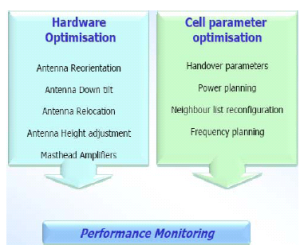With Scarce Spectrum and Number of users per BTS going up, Mobile Operators are looking at optimizing their networks and fine tune the performance to accommodate more. We’ll discuss the Fine-tuning / optimizing radio networks so that any Mobile Network enthusiast can get to know the same without actually being an engineer.
Radio networks comprise a large number of base stations, where each base station covers a limited area called a ‘cell’. Boosting the signal capacity at each cell level can result in a significant reduction in congestion at the network level. Some ways of
addressing this include,
- proposing new sites or sector additions
- BTS equipment/filter change
- proposing antenna azimuth/tilt changes
- proposing antenna type changes
- reconfiguring the frequency allocation to cells and
- changing power parameters
 Radio network cells can be divided into a number of geographic subareas (sectors), which can be increased by increasing the number of antennas – this, too, enhances cell capacity. However, such sectorisation can give rise to handover issues. The impact of sectorisation can be improved by adopting Multiple-Input and Multiple-Output, which involves deploying multiple antennas at both the transmitter and the receiver to improve radio networks.
Radio network cells can be divided into a number of geographic subareas (sectors), which can be increased by increasing the number of antennas – this, too, enhances cell capacity. However, such sectorisation can give rise to handover issues. The impact of sectorisation can be improved by adopting Multiple-Input and Multiple-Output, which involves deploying multiple antennas at both the transmitter and the receiver to improve radio networks.